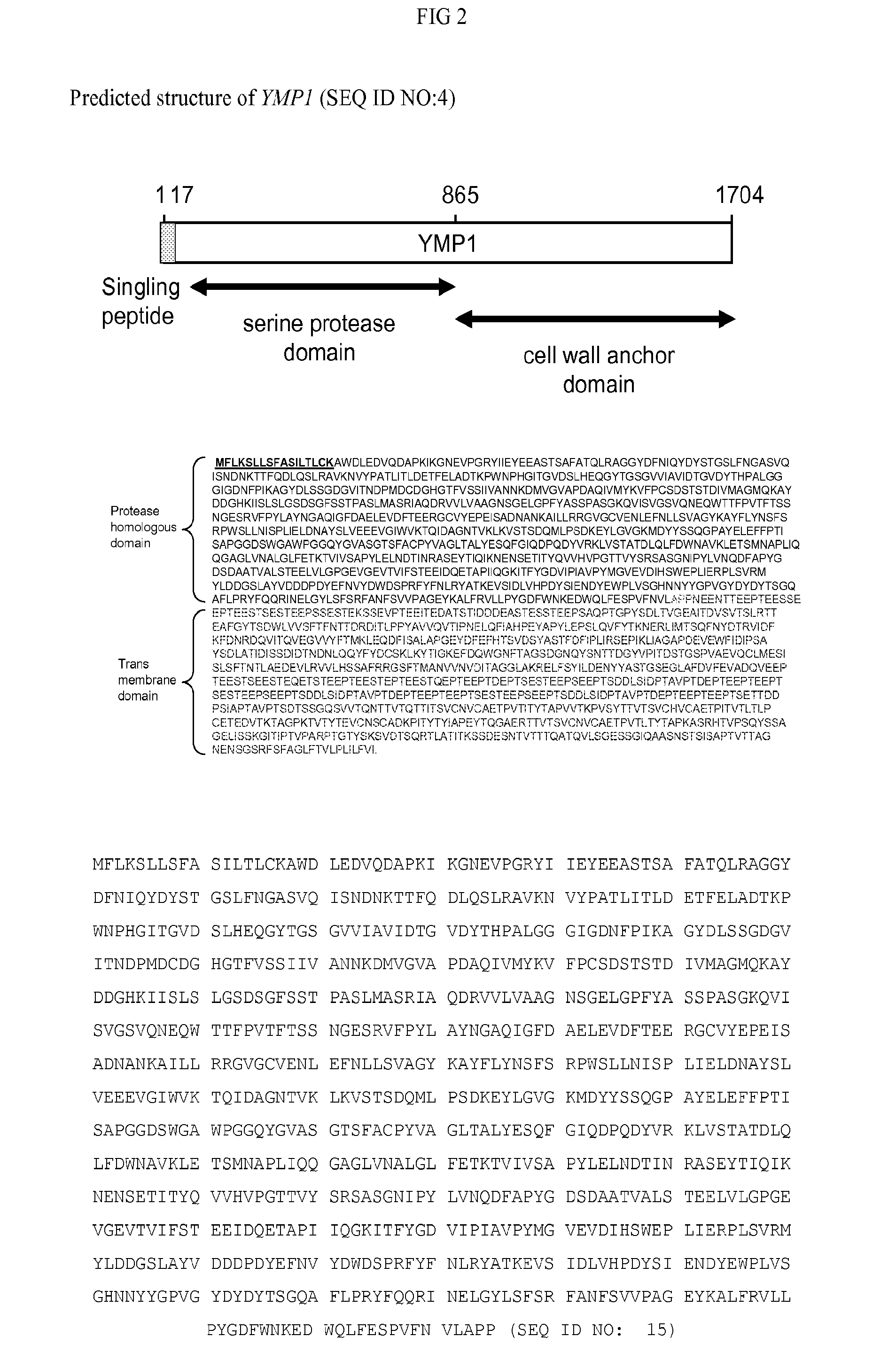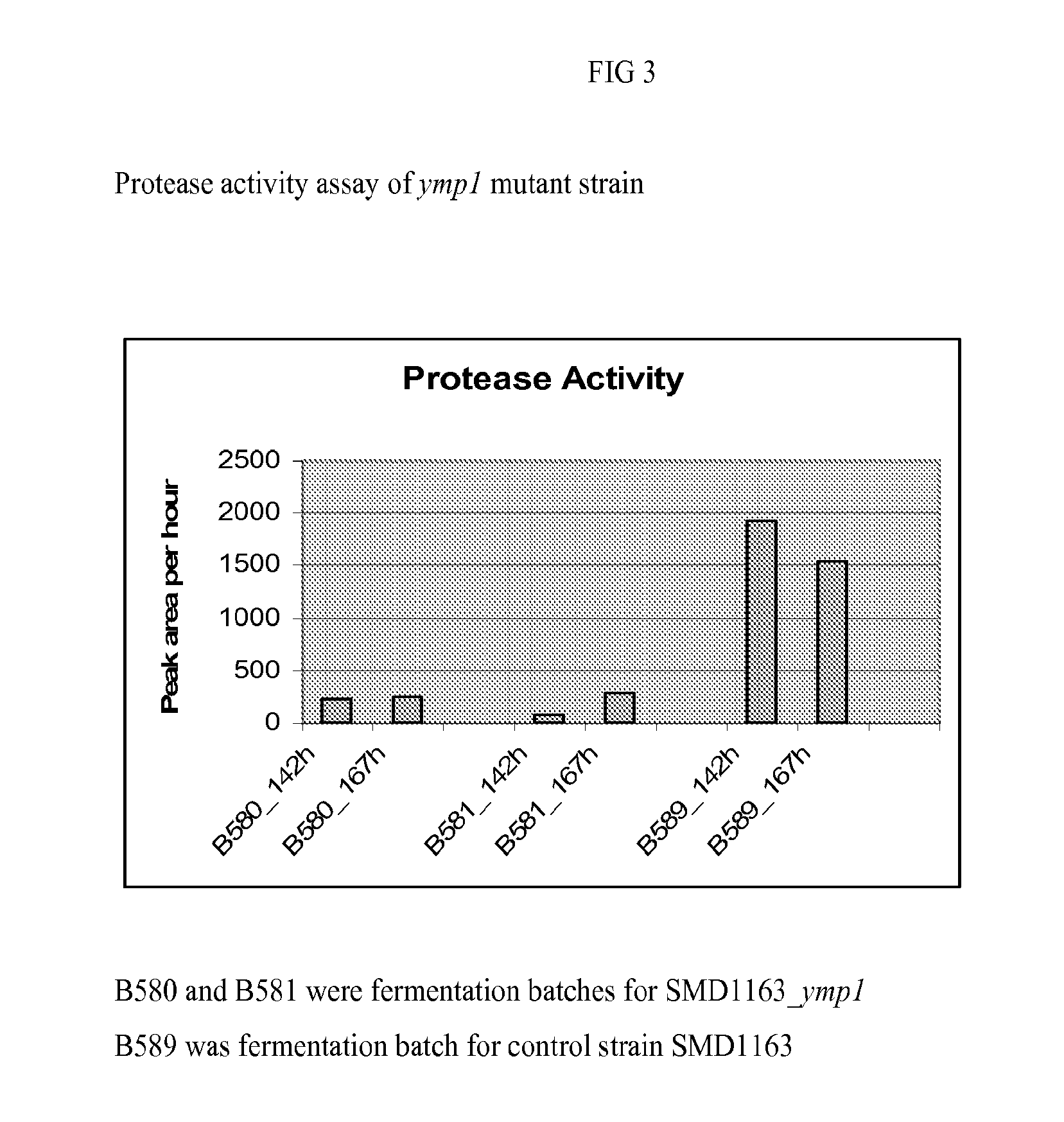Host cells and methods of use
a technology of host cells and host cells, applied in the field of biochemical engineering, can solve the problems of undesired proteolysis and glycosylation of other therapeutic polypeptides including polypeptides genetically fused with hsa
- Summary
- Abstract
- Description
- Claims
- Application Information
AI Technical Summary
Benefits of technology
Problems solved by technology
Method used
Image
Examples
example 1
[0085]A novel protease was identified from Pichia culture supernatant using affinity purification and LC / MS analysis. FIG. 1 shows a novel Pichia yeast methylotropic protease (Ymp1) identified on the gel. Clarified filtered supernatant from B378 (Pichia null strain) was incubated overnight with biotinylated aprotinin. The supernatant was loaded onto a 2 mL avidin column (Pierce) and washed with PBS. The column was eluted sequentially with 0.1M Tris, 2M Sodium chloride, pH7.5, then 0.1M Sodium acetate, 2M Sodium chloride, pH4.5 and finally Biotin Elution Buffer (Pierce). The eluates were concentrated and run on SDS-PAGE. The most prominent bands, Bands 1 and 2 were excised from the gel, reduced, alkylated and digested with trypsin in situ. The tryptic peptides from each band were analyzed by liquid chromatography-tandem mass spectrometry. Un-interpreted sequence data were searched against the Pichia contig-peptide database (Integrated Genetics) using Mascot protein identif...
example 2
Novel Proteases
[0087]Two additional novel yeast methylotropic proteases (Ymp2 and Ymp3) were identified using similar affinity purification and LC / MS analysis as described in Example 1 from supernatant of a Pichia ymp1 knockout strain (see Example 3). Clarified filtered supernatant from B580 (Pichia ymp1 deletion strain) was incubated overnight with biotinylated AEBSF (4-(2-Aminoethyl) benzenesulfonyl fluoride hydrochloride). The supernatant was loaded onto a 10 mL avidin column (Pierce) and washed with PBS. The column was eluted sequentially with 0.1M Tris, 2M Sodium chloride, pH7.5, then 0.1M Sodium acetate, 2M Sodium chloride, pH4.5 and finally Biotin Elution Buffer (Pierce). The eluates were denatured by adding 8 M urea, and the Cys residues were reduced by reaction with 20 mM dithiothreitol (DTT) and then alkylated by reaction with 20 mM iodoacetamide. After diluting the sample to 2 M urea with 100 mM ammonium bicarbonate (pH 8.5), proteins were digested by trypsin (Sequencing ...
example 3
Protease Knockouts
[0091]Several Pichia knockout strains were generated by the following methods. The 5′ end the gene to be knocked out (200-500 bp) was amplified from Pichia genomic DNA by PCR using a 5′ gene specific primer and a 3′ gene specific primer with a 20 bp sequence complementary to the 5′ end of selection marker expression cassette, e.g. KanMX. The 3′ end the gene to be knocked out (200-500 bp) was also amplified from Pichia genomic DNA by PCR using a 5′ gene specific primer with a 20 bp sequence complementary to the 3′ end of KanMX expression cassette and a 3′ gene specific primer. In a separate PCR reaction, a proper amount of 5′ product, 3′ product, DNA containing KanMX expression cassette, and the 5′ and 3′ gene specific primers used before were added to make a knockout cassette which has the KanMX expression cassette flanking 5′ and 3′ homologous regions of the knockout gene. The DNA fragment was purified and transformed into Pichia using a standard electroporation m...
PUM
| Property | Measurement | Unit |
|---|---|---|
| Fraction | aaaaa | aaaaa |
| Volume | aaaaa | aaaaa |
| Bond length | aaaaa | aaaaa |
Abstract
Description
Claims
Application Information
 Login to View More
Login to View More - R&D
- Intellectual Property
- Life Sciences
- Materials
- Tech Scout
- Unparalleled Data Quality
- Higher Quality Content
- 60% Fewer Hallucinations
Browse by: Latest US Patents, China's latest patents, Technical Efficacy Thesaurus, Application Domain, Technology Topic, Popular Technical Reports.
© 2025 PatSnap. All rights reserved.Legal|Privacy policy|Modern Slavery Act Transparency Statement|Sitemap|About US| Contact US: help@patsnap.com



